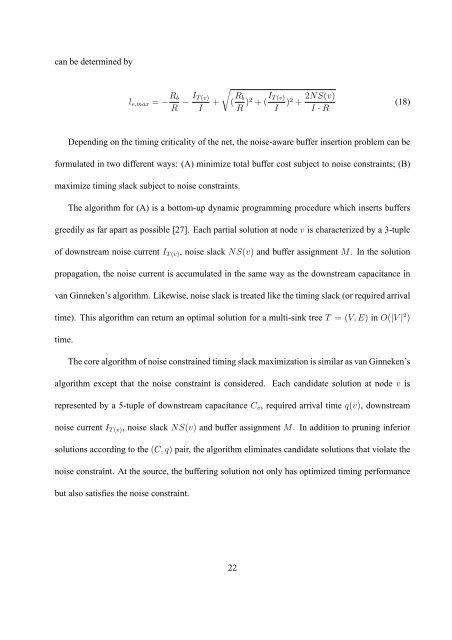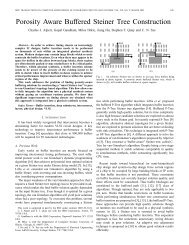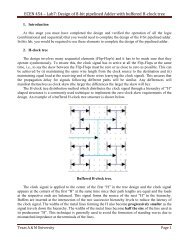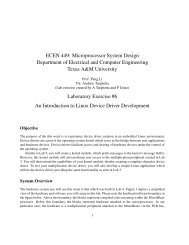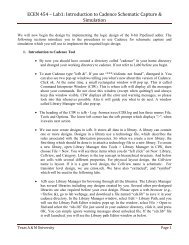Buffer Insertion Basics - Computer Engineering & Systems Group ...
Buffer Insertion Basics - Computer Engineering & Systems Group ...
Buffer Insertion Basics - Computer Engineering & Systems Group ...
Create successful ePaper yourself
Turn your PDF publications into a flip-book with our unique Google optimized e-Paper software.
can be determined by<br />
l e,max = − R b<br />
R − I T(v)<br />
+<br />
I<br />
√<br />
( R b<br />
R )2 + ( I T(v)<br />
)<br />
I<br />
2 + 2NS(v)<br />
I · R<br />
(18)<br />
Depending on the timing criticality of the net, the noise-aware buffer insertion problem can be<br />
formulated in two different ways: (A) minimize total buffer cost subject to noise constraints; (B)<br />
maximize timing slack subject to noise constraints.<br />
The algorithm for (A) is a bottom-up dynamic programming procedure which inserts buffers<br />
greedily as far apart as possible [27]. Each partial solution at node v is characterized by a 3-tuple<br />
of downstream noise current I T(v) , noise slack NS(v) and buffer assignment M. In the solution<br />
propagation, the noise current is accumulated in the same way as the downstream capacitance in<br />
van Ginneken’s algorithm. Likewise, noise slack is treated like the timing slack (or required arrival<br />
time). This algorithm can return an optimal solution for a multi-sink tree T = (V,E) in O(|V | 2 )<br />
time.<br />
The core algorithm of noise constrained timing slack maximization is similar as van Ginneken’s<br />
algorithm except that the noise constraint is considered. Each candidate solution at node v is<br />
represented by a 5-tuple of downstream capacitance C v , required arrival time q(v), downstream<br />
noise current I T(v) , noise slack NS(v) and buffer assignment M. In addition to pruning inferior<br />
solutions according to the (C,q) pair, the algorithm eliminates candidate solutions that violate the<br />
noise constraint. At the source, the buffering solution not only has optimized timing performance<br />
but also satisfies the noise constraint.<br />
22


